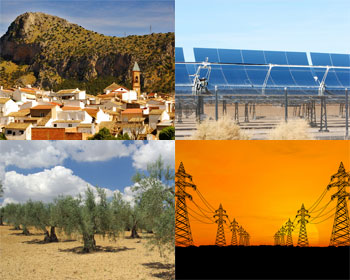A Publication of the
Applied Math and Science Education Repository

The AMSER Science Reader Monthly aims to provide educators with a useful package of information about a particular topic related to applied math and science by combining freely available articles from popular journals with curriculum, learning objects, and web sites from the AMSER portal. The AMSER Science Reader Monthly is free to use in the classroom and educators are encouraged to contact AMSER with suggestions for upcoming issues or comments and concerns at [email protected].
This month's AMSER Science Reader Monthly topic is Sustainable Agriculture.
A Spanish Breakthrough in Harnessing Solar Power
Article
by Richard Covington
Synopsis and resource annotations by Max Grinnell

The quest for effective and large-scale solar power projects has intensified in the past several years, and recent developments in Spain are pointing the way forward. This article by Richard Covington appeared in the August 2010 issue of Smithsonian Magazine, and it documents the transformation of a renewable energy source once viewed as somewhat marginal.
The article begins by describing the Solúcar solar farm, which is located west of the city of Seville. At the farm, the engineers and workers are implementing new and creative technology designed to make the existing technology more efficient. One of the ways this is being done is through the use of concentrated solar power (CSP), which deploys huge banks of mirrors to focus radiation. The resulting heat drives steam turbines, which produce electricity.
All told, these CSP facilities will eventually generate 300 megawatts, enough to power all of metropolitan Seville. Of course, there are many days from November to March (usually about 80 or so), when the solar installation shuts down entirely due to overcast skies or rain. This is a fact of life acknowledged by Valerio Fernández, Solúcar's operations manager, who remarked, "If we are seeking to make solar power more efficient, there are better places than Seville."
The piece continues by exploring a relatively new innovation in solar power storage systems at the facility outside of Seville. Here the Solúcar company is working on their first CSP facility to use parabolic trough technology. This technology uses mirrors which resemble shallow troughs, and at their focal point is a transparent tube filled with synthetic oil. Sunlight will be directed to the tubes, and the heated oil will be used to boil water for turbine-driving steam.
Finally, the article concludes by noting that there are plans to develop similar solar power facilities in North Carolina, New Mexico, and California. The hope is that by 2025 such facilities might be able to power a city of six million. It's an optimistic and inspiring thought, especially for those who have persevered in this field for decades.
Found below is a list of useful resources that will illuminate and enhance understanding of the topics found within this article. The first link will take interested parties to the Built-It-Solar site. Here they will find plans and tools on how to create renewable energy projects, and there are also demonstrations of electric motors and related technologies. Moving on, the second link will take visitors to the National Renewable Energy Laboratory's page of educational resources about renewable energy. The third link leads to an excellent resource from Teachers' Domain and the NOVA television program. Here visitors can check out an interactive activity (complete with animations) that is intended to teach students about how a solar cell works and its various components. The fourth link leads to another fine resource from NOVA which includes a section on how solar panels function and a Q&A area about solar energy. The fifth link is a real find for science educators, as it includes 23 lesson plans in alternative energy created by the New York State Energy Research and Development Authority. The plans cover the efficiency of energy conversion, environmental pollution, and the photoelectric effect. The final link will lead interested parties to an energy tutorial offered by the National Fuel Cell Research Center at the University of California, Irvine.




